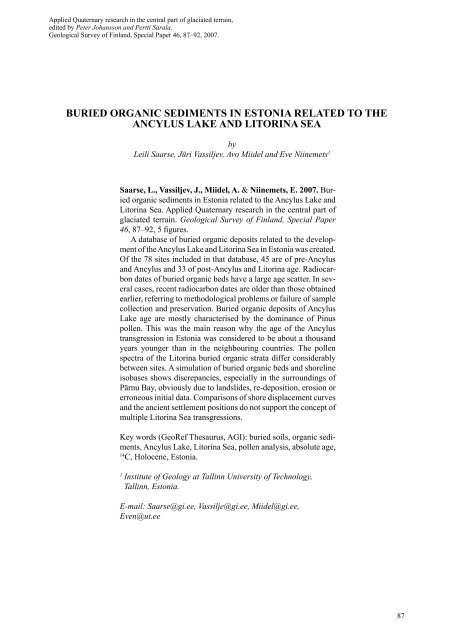Geological Survey of Finland, Special Paper 46 - arkisto.gsf.fi
Geological Survey of Finland, Special Paper 46 - arkisto.gsf.fi
Geological Survey of Finland, Special Paper 46 - arkisto.gsf.fi
Create successful ePaper yourself
Turn your PDF publications into a flip-book with our unique Google optimized e-Paper software.
Applied Quaternary research in the central part <strong>of</strong> glaciated terrain,<br />
edited by Peter Johansson and Pertti Sarala.<br />
<strong>Geological</strong> <strong>Survey</strong> <strong>of</strong> <strong>Finland</strong>, <strong>Special</strong> <strong>Paper</strong> <strong>46</strong>, 87–92, 2007.<br />
BURIED ORGANIC SEDIMENTS IN ESTONIA RELATED TO THE<br />
ANCYLUS LAKE AND LITORINA SEA<br />
by<br />
Leili Saarse, Jüri Vassiljev, Avo Miidel and Eve Niinemets 1<br />
Saarse, L., Vassiljev, J., Miidel, A. & Niinemets, E. 2007. Buried<br />
organic sediments in Estonia related to the Ancylus Lake and<br />
Litorina Sea. Applied Quaternary research in the central part <strong>of</strong><br />
glaciated terrain. <strong>Geological</strong> <strong>Survey</strong> <strong>of</strong> <strong>Finland</strong>, <strong>Special</strong> <strong>Paper</strong><br />
<strong>46</strong>, 87–92, 5 <strong>fi</strong> gures.<br />
A database <strong>of</strong> buried organic deposits related to the development<br />
<strong>of</strong> the Ancylus Lake and Litorina Sea in Estonia was created.<br />
Of the 78 sites included in that database, 45 are <strong>of</strong> pre-Ancylus<br />
and Ancylus and 33 <strong>of</strong> post-Ancylus and Litorina age. Radiocarbon<br />
dates <strong>of</strong> buried organic beds have a large age scatter. In several<br />
cases, recent radiocarbon dates are older than those obtained<br />
earlier, referring to methodological problems or failure <strong>of</strong> sample<br />
collection and preservation. Buried organic deposits <strong>of</strong> Ancylus<br />
Lake age are mostly characterised by the dominance <strong>of</strong> Pinus<br />
pollen. This was the main reason why the age <strong>of</strong> the Ancylus<br />
transgression in Estonia was considered to be about a thousand<br />
years younger than in the neighbouring countries. The pollen<br />
spectra <strong>of</strong> the Litorina buried organic strata differ considerably<br />
between sites. A simulation <strong>of</strong> buried organic beds and shoreline<br />
isobases shows discrepancies, especially in the surroundings <strong>of</strong><br />
Pärnu Bay, obviously due to landslides, re-deposition, erosion or<br />
erroneous initial data. Comparisons <strong>of</strong> shore displacement curves<br />
and the ancient settlement positions do not support the concept <strong>of</strong><br />
multiple Litorina Sea transgressions.<br />
Key words (GeoRef Thesaurus, AGI): buried soils, organic sediments,<br />
Ancylus Lake, Litorina Sea, pollen analysis, absolute age,<br />
14 C, Holocene, Estonia.<br />
1 Institute <strong>of</strong> Geology at Tallinn University <strong>of</strong> Technology,<br />
Tallinn, Estonia.<br />
E-mail: Saarse@gi.ee, Vassilje@gi.ee, Miidel@gi.ee,<br />
Even@ut.ee<br />
87

















